Page 65 of 96
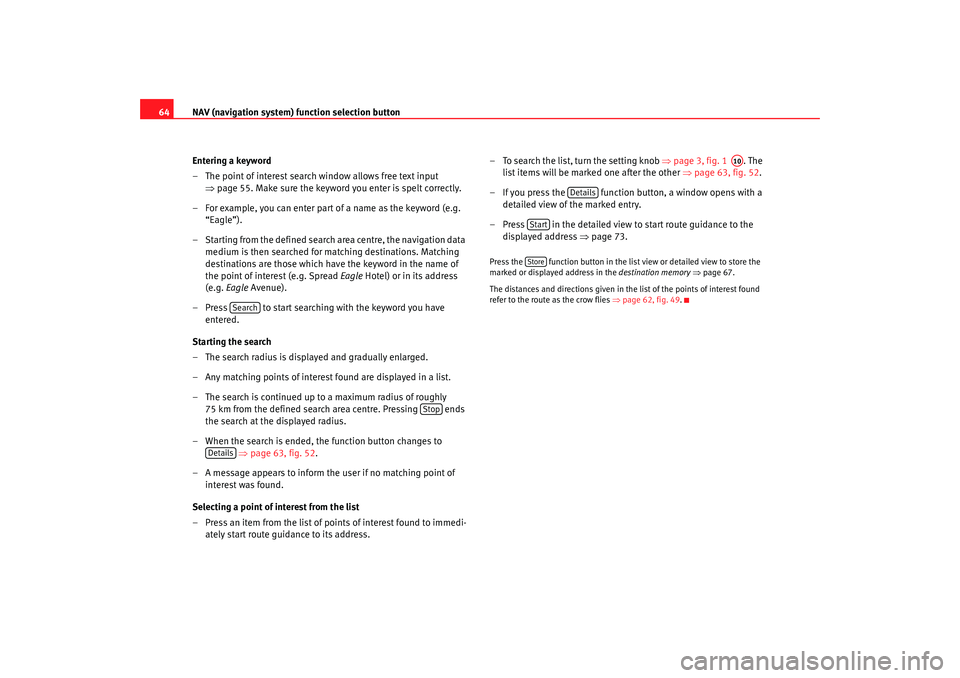
NAV (navigation system) function selection button
64
Entering a keyword
– The point of interest search window allows free text input ⇒page 55. Make sure the keyword you enter is spelt correctly.
– For example, you can enter part of a name as the keyword (e.g. “Eagle”).
– Starting from the defined search area centre, the navigation data medium is then searched for matching destinations. Matching
destinations are those which have the keyword in the name of
the point of interest (e.g. Spread Eagle Hotel) or in its address
(e.g. Eagle Avenue).
– Press to start searching with the keyword you have entered.
Starting the search
– The search radius is displayed and gradually enlarged.
– Any matching points of interest found are displayed in a list.
– The search is continued up to a maximum radius of roughly
75 km from the defined search area centre. Pressing ends
the search at the displayed radius.
– When the search is ended, the function button changes to ⇒ page 63, fig. 52 .
– A message appears to inform the user if no matching point of interest was found.
Selecting a point of interest from the list
– Press an item from the list of points of interest found to immedi- ately start route guidance to its address. – To search the list, turn the setting knob
⇒page 3, fig. 1 . The
list items will be marked one after the other ⇒page 63, fig. 52 .
– If you press the function button, a window opens with a detailed view of the marked entry.
– Press in the detailed view to start route guidance to the displayed address ⇒ page 73.
Press the function button in the list view or detailed view to store the
marked or displayed address in the destination memory ⇒page 67.
The distances and directions given in the list of the points of interest found
refer to the route as the crow flies ⇒page 62, fig. 49 .
Search
Stop
Details
A10
Details
StartStore
media_system_ingles.book Seite 64 Donnerstag, 5. Februar 2009 3:31 15
Page 66 of 96
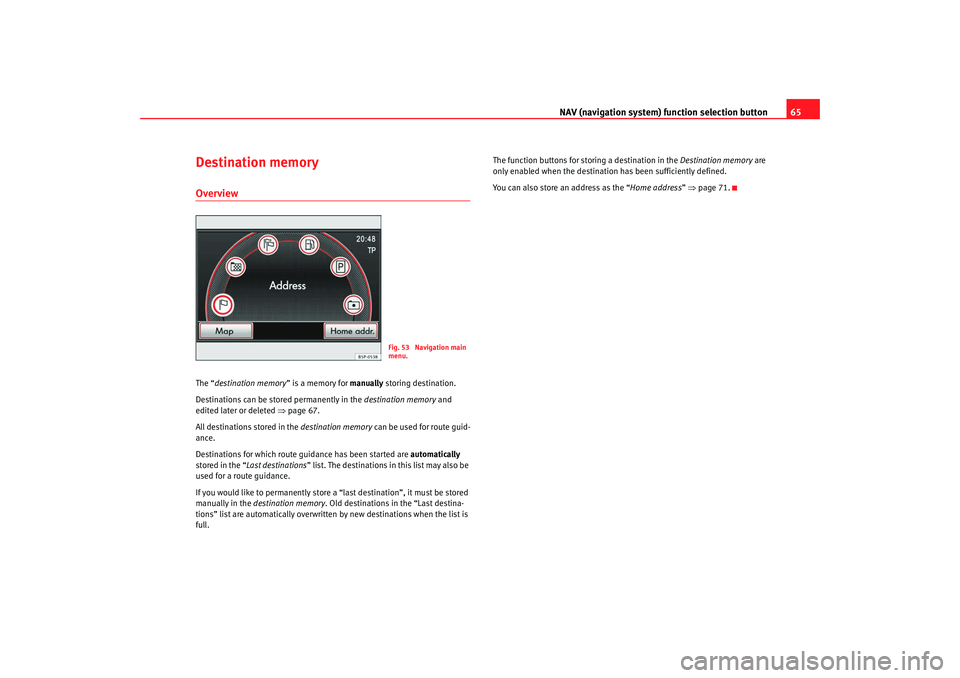
NAV (navigation system) function selection button 65
Destination memoryOverviewThe “destination memory ” is a memory for manually storing destination.
Destinations can be stored permanently in the destination memory and
edited later or deleted ⇒page 67.
All destinations stored in the destination memory can be used for route guid-
ance.
Destinations for which route guidance has been started are automatically
stored in the “ Last destinations ” list. The destinations in this list may also be
used for a route guidance.
If you would like to permanently store a “last destination”, it must be stored
manually in the destination memory . Old destinations in the “Last destina-
tions” list are automatically overwritten by new destinations when the list is
full. The function buttons for st
oring a destination in the Destination memory are
only enabled when the destination has been sufficiently defined.
You can also store an address as the “ Home address” ⇒ page 71.
Fig. 53 Navigation main
menu.
media_system_ingles.book Seite 65 Donnerstag, 5. Februar 2009 3:31 15
Page 67 of 96
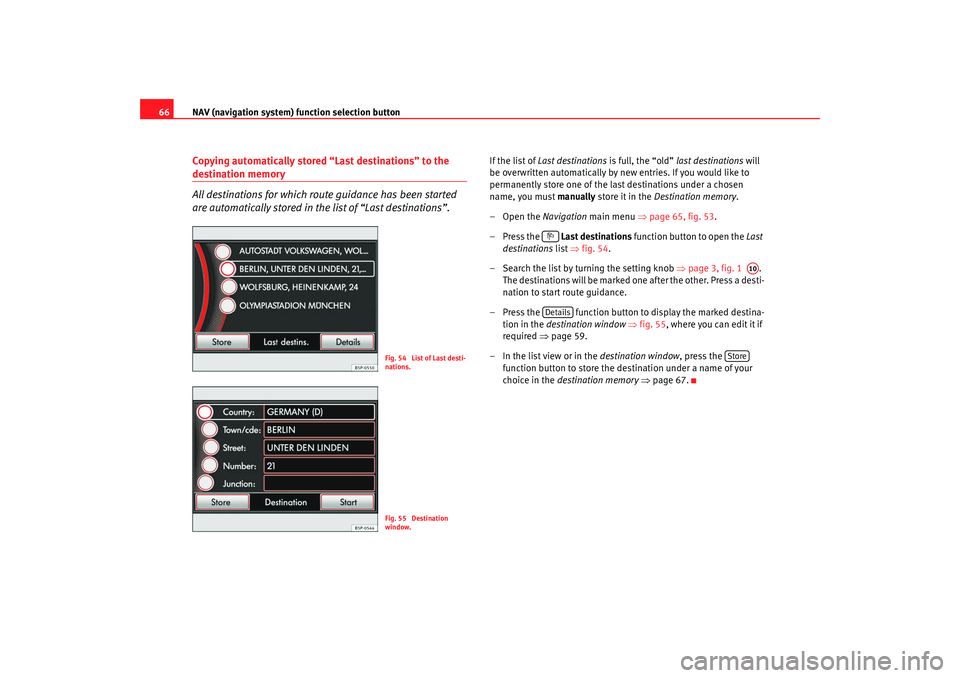
NAV (navigation system) function selection button
66Copying automatically stored “Last destinations” to the destination memory
All destinations for which route guidance has been started
are automatically stored in the list of “Last destinations”.
If the list of Last destinations is full, the “old” last destinations will
be overwritten automatically by new entries. If you would like to
permanently store one of the last destinations under a chosen
name, you must manually store it in the Destination memory .
–Open the Navigation main menu ⇒page 65, fig. 53 .
–Press the Last destinations function button to open the Last
destinations list ⇒fig. 54.
– Search the list by turning the setting knob ⇒page 3, fig. 1 .
The destinations will be marked one after the other. Press a desti-
nation to start route guidance.
– Press the function button to display the marked destina- tion in the destination window ⇒fig. 55 , where you can edit it if
required ⇒page 59.
– In the list view or in the destination window, press the
function button to store the destination under a name of your
choice in the destination memory ⇒ page 67.
Fig. 54 List of Last desti-
nations.Fig. 55 Destination
window.
A10
Details
Store
media_system_ingles.book Seite 66 Donnerstag, 5. Februar 2009 3:31 15
Page 68 of 96
NAV (navigation system) function selection button 67
Storing destinations manually
When storing destinations in the destination memory, you
can either use the name offered by the system or you can
assign your own choice of name to enable you to find the
destination again more easily.If a destination is displayed with the function button enabled,
the destination can be stored in the Destination memory (e.g.
⇒ page 66, fig. 55).
– If you press the function button, an input window is opened where you can assign an entry name ⇒fig. 56 .
– Press to apply the name currently displayed.
– To assign a name of your choice, first press and then enter your chosen name as described ⇒page 55, “Input mask
for open text”. – Choose an informative name to make it easy for you to find the
destination again.
Fig. 56 Input window for
assigning your own entry
name.
Store
Store
OK
Delete
media_system_ingles.book Seite 67 Donnerstag, 5. Februar 2009 3:31 15
Page 69 of 96
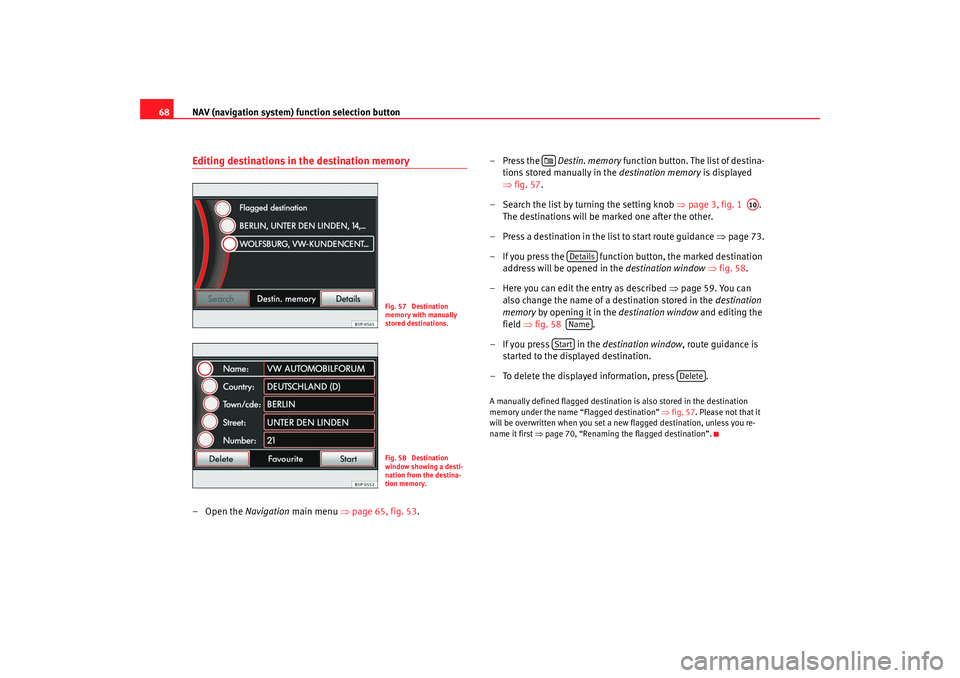
NAV (navigation system) function selection button
68Editing destinations in the destination memory–Open the Navigation main menu ⇒page 65, fig. 53 . –Press the Destin. memory
function button. The list of destina-
tions stored manually in the destination memory is displayed
⇒ fig. 57.
– Search the list by turning the setting knob ⇒page 3, fig. 1 .
The destinations will be marked one after the other.
– Press a destination in the list to start route guidance ⇒page 73.
– If you press the function button, the marked destination address will be opened in the destination window ⇒fig. 58 .
– Here you can edit the entry as described ⇒ page 59. You can
also change the name of a destination stored in the destination
memory by opening it in the destination window and editing the
field ⇒fig. 58 .
– If you press in the destination window, route guidance is
started to the displayed destination.
– To delete the displayed information, press .
A manually defined flagged destination is also stored in the destination
memory under the name “Flagged destination” ⇒fig. 57 . Please not that it
will be overwritten when you set a new flagged destination, unless you re-
name it first ⇒page 70, “Renaming the flagged destination”.
Fig. 57 Destination
memory with manually
stored destinations.Fig. 58 Destination
window showing a desti-
nation from the destina-
tion memory.
A10
DetailsName
Start
Delete
media_system_ingles.book Seite 68 Donnerstag, 5. Februar 2009 3:31 15
Page 70 of 96
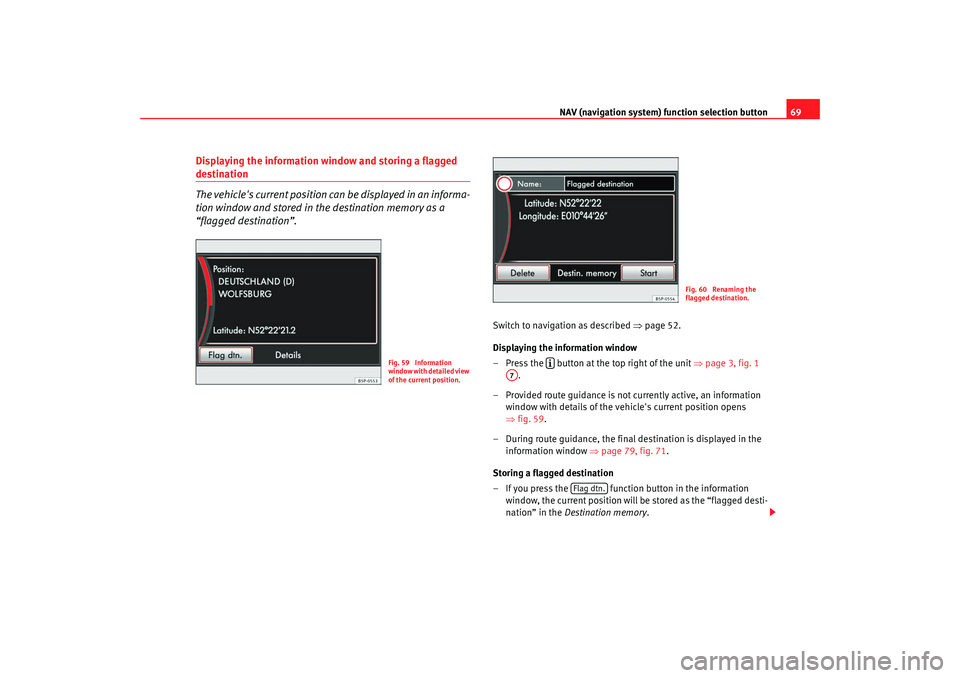
NAV (navigation system) function selection button 69
Displaying the information window and storing a flagged destination
The vehicle's current position can be displayed in an informa-
tion window and stored in the destination memory as a
“flagged destination”.
Switch to navigation as described ⇒page 52.
Displaying the information window
– Press the button at the top right of the unit ⇒ page 3, fig. 1
.
– Provided route guidance is not currently active, an information window with details of the vehicle's current position opens
⇒fig. 59 .
– During route guidance, the final destination is displayed in the information window ⇒page 79, fig. 71 .
Storing a flagged destination
– If you press the function button in the information window, the current position will be stored as the “flagged desti-
nation” in the Destination memory .
Fig. 59 Information
window with detailed view
of the current position.
Fig. 60 Renaming the
flagged destination.
A7
Flag dtn.
media_system_ingles.book Seite 69 Donnerstag, 5. Februar 2009 3:31 15
Page 71 of 96
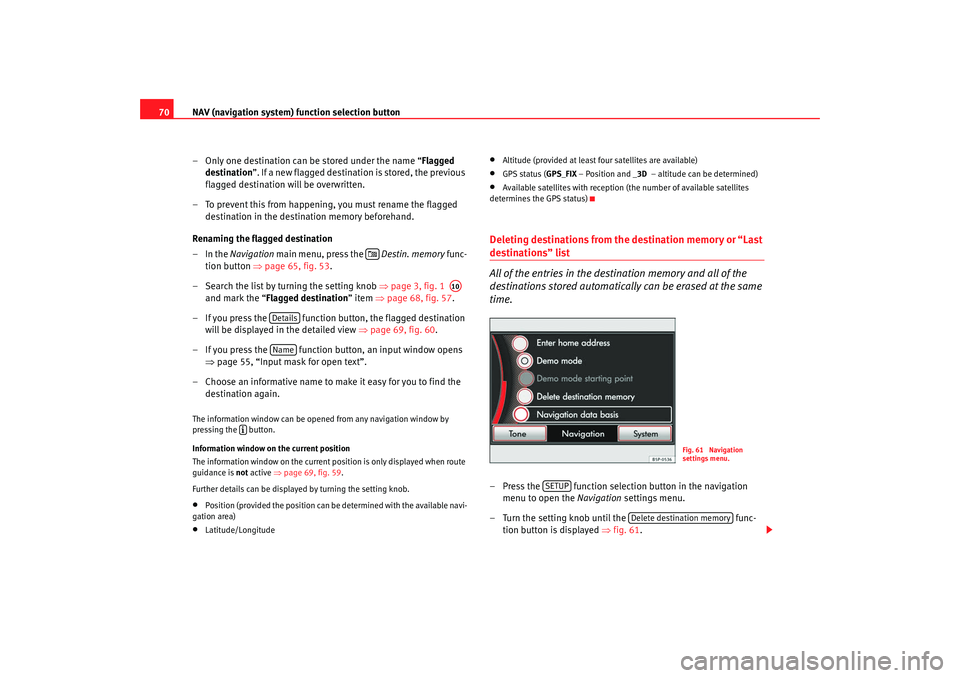
NAV (navigation system) function selection button
70
– Only one destination can be stored under the name “ Flagged
destination”. If a new flagged destination is stored, the previous
flagged destination will be overwritten.
– To prevent this from happening, you must rename the flagged destination in the destination memory beforehand.
Renaming the flagged destination
–In the Navigation main menu, press the Destin. memory func-
tion button ⇒page 65, fig. 53 .
– Search the list by turning the setting knob ⇒page 3, fig. 1
and mark the “Flagged destination ” item ⇒page 68, fig. 57 .
– If you press the function button, the flagged destination will be displayed in the detailed view ⇒ page 69, fig. 60.
– If you press the function button, an input window opens ⇒page 55, “Input mask for open text”.
– Choose an informative name to make it easy for you to find the destination again.The information window can be opened from any navigation window by
pressing the button.
Information window on the current position
The information window on the current po sition is only displayed when route
guidance is not active ⇒page 69, fig. 59 .
Further details can be displayed by turning the setting knob.•
Position (provided the position can be determined with the available navi-
gation area)
•
Latitude/Longitude
•
Altitude (provided at least four satellites are available)
•
GPS status ( GPS_FIX – Position and _3D – altitude can be determined)
•
Available satellites with reception (the number of available satellites
determines the GPS status)
Deleting destinations from the destination memory or “Last destinations” list
All of the entries in the destination memory and all of the
destinations stored automatically can be erased at the same
time.– Press the function selection button in the navigation
menu to open the Navigation settings menu.
– Turn the setting knob until the func-
tion button is displayed ⇒fig. 61 .
A10
DetailsName
Fig. 61 Navigation
settings menu.
SETUP
Delete destination memory
media_system_ingles.book Seite 70 Donnerstag, 5. Februar 2009 3:31 15
Page 72 of 96
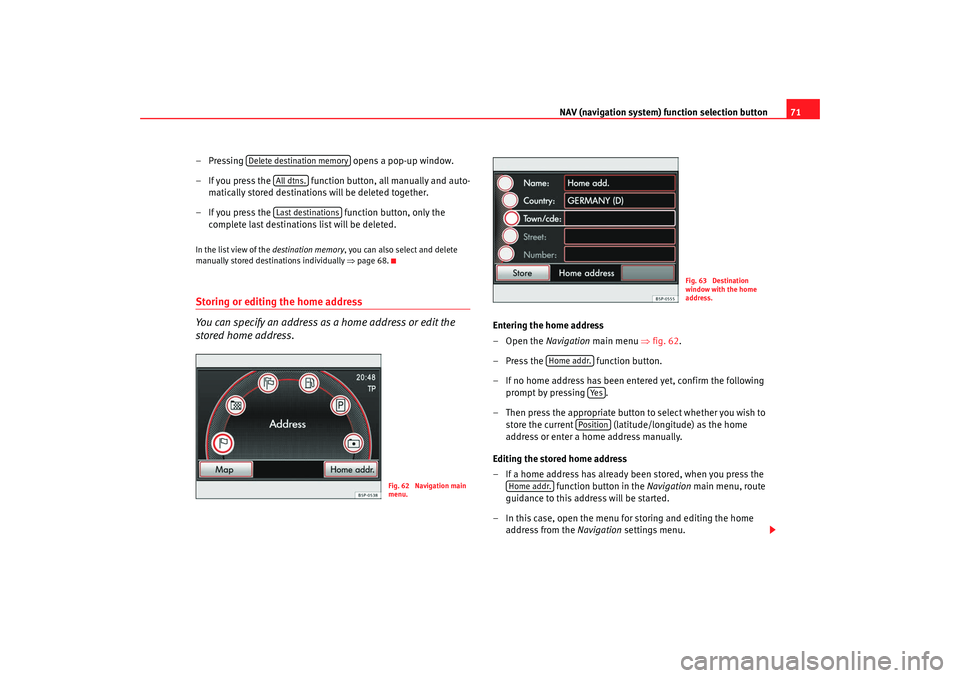
NAV (navigation system) function selection button 71
– Pressing opens a pop-up window.
– If you press the function button, all manually and auto- matically stored destinations will be deleted together.
– If you press the function button, only the
complete last destinations list will be deleted.
In the list view of the destination memory, you can also select and delete
manually stored destinations individually ⇒page 68.Storing or editing the home address
You can specify an address as a home address or edit the
stored home address.
Entering the home address
–Open the Navigation main menu ⇒ fig. 62.
– Press the function button.
– If no home address has been entered yet, confirm the following prompt by pressing .
– Then press the appropriate button to select whether you wish to
store the current (latitude/longitude) as the home
address or enter a home address manually.
Editing the stored home address
– If a home address has already been stored, when you press the function button in the Navigation main menu, route
guidance to this address will be started.
– In this case, open the menu for storing and editing the home address from the Navigation settings menu.
Delete destination memory
All dtns.Last destinations
Fig. 62 Navigation main
menu.
Fig. 63 Destination
window with the home
address.
Home addr.
Ye s
Position
Home addr.
media_system_ingles.book Seite 71 Donnerstag, 5. Februar 2009 3:31 15